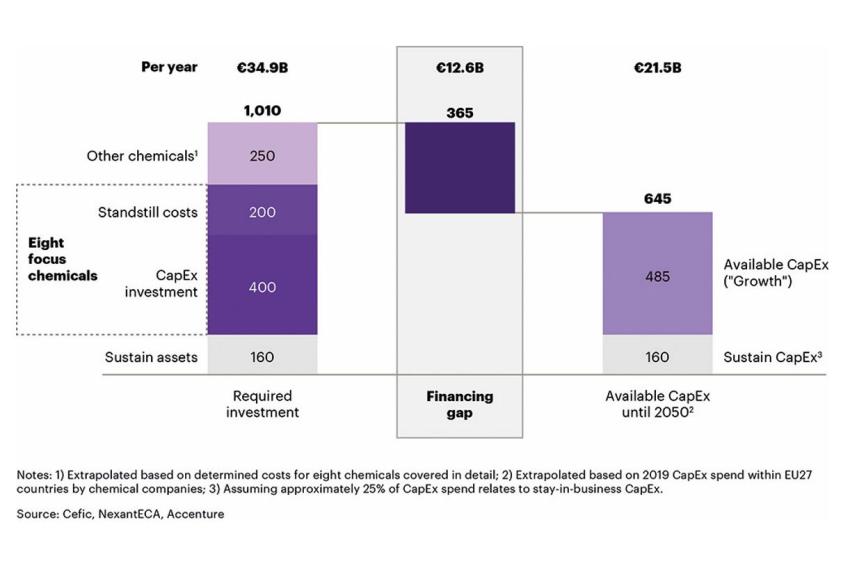The EU Goes Green
Costs and Benefits for European Chemical Companies
The EU Green Deal, which calls for a net-zero carbon Europe by 2050, sets a high bar for reducing greenhouse gas (GHG) emissions, and its impact will be felt across industries. But the chemical sector’s unique nature means that it will be more deeply affected by the Green Deal than other industries — and more deeply involved in making net zero a reality, as well.
The cost to the chemical industry will be high. An in-depth analysis by Accenture and NexantECA shows that the Green Deal will require new technologies and processes, disrupt operations, bring changes to plant networks and ultimately, require heavy investments from the industry. But the Green Deal will bring more than compliance costs. It will also open the door to large increases in demand for innovative new chemical products and create significant new growth opportunities for chemical companies.
Sizing up the Challenge
To reach net zero by 2050, the chemical industry will need to cut GHG emissions dramatically. The industry is no stranger to that type of mandate — over the last three decades, it has reduced annual GHG emissions by 171 million tons. Much of this was accomplished through improvements in technologies and processes, but it was also driven by capacity reductions and plant shutdowns. From 1993 to 2020, the EU share of total global chemical production decreased from 31.6% to 14.4%. To a great extent, the past reductions in emissions were essentially the “easy” cuts. Making the next rounds of reductions needed to meet the Green Deal goals will be more difficult.
The Accenture/NexantECA research underscored the size of that challenge. It looked at the production of eight chemicals — ammonia, ethylene, propylene, nitric acid, carbon black, caprolactam, soda ash and fluorochemicals — that account for 75% of chemical industry greenhouse gas emissions. Based on that assessment, it found that the industry in Europe will have to reduce emissions by another 186 million tons a year by 2050. (That number is higher than some estimates, because it is based on both regulated and non-regulated plants, not just regulated plants.)
Those reductions will come with a very large price tag. Something between € 400 billion and € 600 billion in capital expenditures will be needed for core equipment and the design, construction and modification of facilities. Another € 200 billion to € 300 billion will be incurred as standstill costs — that is, the profits lost due to halted production as plants are retrofitted, improved or rebuilt. And changes to the production processes used for other chemicals beyond the key eight chemicals mentioned previously will require another € 250 billion to € 350 billion. Based on those figures, the overall mid-range estimated Green Deal “bill” for the chemical industry will be more than € 1 trillion. To pay it, the industry will need to fill in a significant funding gap, compared to current capital spending, increasing capital investments by € 12.6 billion a year over the next three decades (see figure)
The challenges ripple beyond those costs and the chemical industry itself. For example, making the necessary changes to plants and plant networks in a timely manner will require capacity expansions at equipment manufacturers and in the engineering, procurement and construction industries. Meanwhile, dramatic increases in renewable electricity will be critical to creating a net-zero chemical industry, requiring an additional 3.2 petawatt-hours (PWh) of renewable energy — about five times the amount generated in the EU today. Much of this will depend on the efforts of utilities and governments, but chemical companies will need to play a role in their planning because the power and chemical sectors are closely intertwined. The electrification of chemical plants will not reduce GHG emissions enough without using renewable energy, and the building of new renewable energy generation cannot be justified without the demand created by more electrification in plants.
„Dramatic increases in renewable electricity
will be critical to creating a net-zero
chemical industry.“
Fortunately, the Green Deal does not ignore these challenges. For example, it calls for the EU to provide more support for increased renewable energy generation, and for regulatory changes that will encourage more low-GHG products and solutions. It recognizes the need for programs that protect against “GHG leakage” by stopping the importing of non-compliant products. And it calls for sustainable financing to help companies fund their net-zero initiatives.
What’s the Upside for the Chemical Industry?
The chemical industry — whose products are the “ingredients” for virtually every sector — is in a unique position in regard to the Green Deal. Like other industries, it needs to make changes to its processes and systems in order to meet the 2050 goals. But it can also play a key role in helping other industries do the same — and that’s where the huge growth opportunity lies.
Virtually every industry will be affected by the EU Green Deal, as well as the growing consumer sentiment that favors low-carbon products. With that in mind, companies in a variety of industries have already made public commitments to sustainability — and they will need to change many of the offerings they bring to market to meet these commitments.
Chemical products will be a big part of the solution for these customer industries. Chemical companies that focus on net-zero innovations and produce new materials that are lighter, lower-carbon, more sustainable and made with processes that result in lower GHG emissions will find expanding markets for their offerings. And this growth in demand will not be restricted to Europe — it will be global because so many global companies have made net-zero commitments that apply to their worldwide operations. As European chemical companies reshape themselves for the Green Deal, they are likely to gain a head start in the race to bring low-carbon, sustainable and circular economy-related solutions to market, giving them a competitive advantage in global markets.
Getting Ready
What can chemical companies do to prepare for this future? To begin, they should assess each plant’s future competitiveness in a lower-carbon world. How can investments in a given plant lead to innovative offerings, such as net-zero or low GHG emission products? Will the plant’s future production costs be competitive globally? The answers to such questions can help identify which plants should be closed, moved or modified.
For chemical companies, the changes needed to reach net zero will be massive, complex and enterprise wide. As a result, each company will need to develop its own detailed roadmap for moving forward — one that defines and integrates technology plans, business portfolio strategies, cost-efficiency initiatives and growth programs. In addition to guiding projects and initiatives, this roadmap will help investors be more comfortable with net-zero driven changes. That comfort will be key to future share prices and, ultimately, the ability to fund net-zero efforts.
„For chemical companies,
the changes needed to reach net zero will be
massive, complex and enterprise wide.”
That kind of planning will need to reach across company borders, as well. Achieving the Green Deal’s goals will involve a variety of interdependent activities that touch on customers, suppliers and partners, and even players from other industries — witness the need to coordinate the design of the chemical plant network with the expansion of renewable energy production, as already discussed. Sectoral roadmaps will be needed to coordinate, sequence and synchronize the activities of these groups, and bring together public-private partnerships, renewable energy initiatives, customer commitments to sustainable products, innovation efforts and technology plans to form a comprehensive approach.
Chemical companies certainly face significant technical and financial challenges with the Green Deal. But by meeting those challenges, the industry can play a critical enabling role in helping the Green Deal succeed. As the “industry of industries,” the chemical industry will be in position to help a tremendous range of companies around the world achieve their net-zero goals and contribute significantly to meeting the global challenge of climate change. And by doing so, it will create a very real opportunity to prosper and grow in a more sustainable, circular future.
Thank you to Accenture’s Michael Ulbrich and Eike Eschenröder, and NexantECA’s Mais Haddadin Finn, Richard Sleep, Nuno Faísca and Alastair Hensman for their contributions to this article.
References can be requested from the author.
Author: Bernd Elser, Managing Director and global chemicals lead, Accenture







